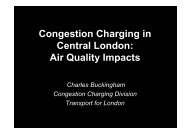Cars and behaviour: psychological barriers to car restraint ... - iapsc
Cars and behaviour: psychological barriers to car restraint ... - iapsc
Cars and behaviour: psychological barriers to car restraint ... - iapsc
You also want an ePaper? Increase the reach of your titles
YUMPU automatically turns print PDFs into web optimized ePapers that Google loves.
crisis the small <strong>and</strong> overloaded Yugo <strong>and</strong> Lada <strong>car</strong>s were the last protection against the<br />
cold <strong>and</strong> the enemy for thous<strong>and</strong>s of homeless refugees.<br />
A device of <strong>psychological</strong> superiority<br />
Rarely, as our analysis shows, has technology provided a more successful satisfier of<br />
basic humans needs <strong>and</strong> motives than the <strong>car</strong> <strong>and</strong> it is very unlikely that the feat will<br />
ever be repeated. Neglecting the <strong>car</strong>’s <strong>psychological</strong> assets, common in transport<br />
research, may lead <strong>to</strong> considerable harm <strong>and</strong> ineffective political choices. Large<br />
investments in either roads or public transport, when primarily based upon economic<br />
reasoning <strong>and</strong> considerations of public acceptability, let alone pressure from the <strong>car</strong>-<br />
industrial-cultural complex, will not contribute <strong>to</strong> <strong>restraint</strong> <strong>and</strong> control. Furthermore, it<br />
may prevent the necessary R&D in<strong>to</strong> new <strong>behaviour</strong>-modifying technologies such as ISA<br />
[Intelligent Speed Adaptation] <strong>and</strong> new forms of road pricing. Public transport is clearly<br />
at such a great <strong>and</strong> insurmountable <strong>psychological</strong> disadvantage that it can never hope<br />
<strong>to</strong> close the gap on its own.<br />
Interventions<br />
The question then remains, how is man <strong>to</strong> protect himself against the <strong>car</strong> when it poses<br />
a threat <strong>to</strong> himself <strong>and</strong> his environment? A psychologist's answer would be <strong>to</strong> see the<br />
<strong>car</strong>-man as a preda<strong>to</strong>r <strong>and</strong> the pedestrian <strong>and</strong> cyclist as its prey. It is up <strong>to</strong> the latter <strong>to</strong><br />
devise methods of increasing their freedom of movement - <strong>and</strong> at the same time<br />
reducing their fear - while restricting that of the preda<strong>to</strong>ry <strong>car</strong>. These methods must be<br />
17










